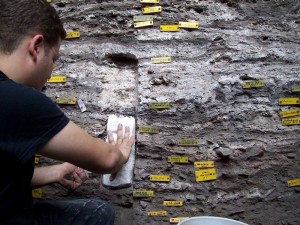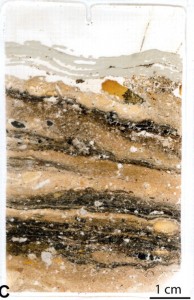 A team of archaeologists has discovered 40,000 years worth of mattresses stacked in South Africa’s Sibudu cave, 25 miles north of Durban. Our Stone Age ancestors made bedding from leaves, seeds and stems of local rushes and grasses on the floor of the cave starting approximately 77,000 years ago. For the next 44,000 years, nomadic Homo sapiens hunted and gathered in the area using Sibudu as their crash pad, compacting the plant material to create sleeping mats.
A team of archaeologists has discovered 40,000 years worth of mattresses stacked in South Africa’s Sibudu cave, 25 miles north of Durban. Our Stone Age ancestors made bedding from leaves, seeds and stems of local rushes and grasses on the floor of the cave starting approximately 77,000 years ago. For the next 44,000 years, nomadic Homo sapiens hunted and gathered in the area using Sibudu as their crash pad, compacting the plant material to create sleeping mats.
Researchers found at least 15 1-centimeter thick layers of plant matter embedded within a chunk of sediment 10 feet thick. They suspected the layers were human bedding, but since the oldest sleeping mats discovered up until now were only between 20,000 and 30,000 years old, archaeologists had to study the material under the microscope to see what exactly it was composed of and whether people brought the plants to the site intentionally.
Reporting online today in Science, Wadley and her colleagues describe the results of two sophisticated archaeological techniques: analysis of phytoliths, tiny fossil plant remains, which allows identification of plant species; and micromorphology, the high-resolution examination of archaeological remains.
The team found that the swaths, which dated from 77,000 to 58,000 years ago, were made from sedges, rushes, and grasses, plants that grow down by the Tongati River but are not found in the dry rock shelter. Thus the people at Sibudu must have gathered them deliberately and brought them to the cave. Under the microscope, blocks of the plant material showed signs of compression and repeated trampling. In the earliest layer, 77,000 years old, the team found the leaves of Cryptocarya woodii, also known as Cape laurel, or the “bastard camphor tree,” an aromatic plant whose leaves are used in traditional medicines even today. The leaves contain several chemical compounds that can kill insects, and the team suggests that early humans chose them to protect against malaria-carrying mosquitoes and other pests.
 The layers also showed evidence of regular burning, starting 73,000 years ago. Archaeologists believe people burned the bedding to eliminate pests that had infested the plants, and/or to reduce the accumulated height of old, decayed mats so they could start again clean. This is the first example known of humans using fire for dwelling maintenance.
The layers also showed evidence of regular burning, starting 73,000 years ago. Archaeologists believe people burned the bedding to eliminate pests that had infested the plants, and/or to reduce the accumulated height of old, decayed mats so they could start again clean. This is the first example known of humans using fire for dwelling maintenance.
The inhabitants of the cave would not have lived there permanently, despite having made it so nice and cozy. They probably used the space for weeks at a time until the area was hunted out and the organic material started rotting or attracting vermin. Archaeologists found fragments of stone chips and burnt bone amidst the plant matter, so in addition to use the mats for sleeping, their creators also used them as a work surface for making tools and food.
Around 58,000 years ago, the bedding layers become more frequent, suggesting that the population in Sibudu was growing during this period. Archaeologists estimate that Homo sapiens migrated from Africa 50,000 years ago, perhaps in the wake of that very population boom.
I see there’s no research indicating when we started using peas to locate young royalty.
There is not. Big Archaeology doesn’t want the world to know.
Has anything been mentioned about finding human hair in the bedding?
Not that I’ve seen. I imagine shed hair would be very easily consumed by fire, more so than the compacted plant matter.
Really cool that they found evidence of a possible population boom related to increase in bedding, possibly connected to when humans first started migrating around the planet.